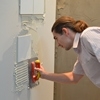Ceramic tile is a blocky, repeating element of a wall or floor surface. The quality and value of the cladding directly depend on the symmetry and uniformity of its individual components, i.e. individual tiles in relation to the quality of the surface and its dimensions. That is why, any dimensional differences and asymmetries of the tiles, deviations of the surface from flatness, which violate the harmony of the cladding and worsen its appearance, will be considered defects. At the same time, dimensional differences and asymmetries of tiles are considered defects only in cases where they affect the outer part and functionality of the cladding. Small deviations that are visible only upon very close examination, under certain lighting or through a magnifying glass, are not considered defects, as well as variations in flatness within the established standards. Naturally, the quality of a material cannot be determined taking into account its purpose, i.e. permissible dimensional deviations are not measured with an accuracy of hundredths of a millimeter, as, for example, engine parts.
Dimensional characteristics
Consider the following important dimensional characteristics:
- Side length and thickness . The uniformity of sizes in one batch of goods directly affects the symmetry of the design and the flatness of the lined surface;
- Straightness of the sides . The sides should not have bends;
- Orthogonality . Ceramic tiles must have right angles. Straightness and orthogonality are necessary for the symmetry of the tiled surface. The joints must be straight and equal in width;
- Surface flatness . The importance of defining such a characteristic is undoubted. Otherwise, how to achieve the most even surface possible, without ledges, waves, etc. This is done by measuring center curvature (deviation of the center of the tile from the plane in which 3 of the 4 corners lie), edge curvature (deviation of the center of the edge from the plane in which 3 of the 4 corners lie) and warpage (deviation of the fourth corner of the tile from the plane, in which the remaining angles lie).
As a rule, the difference in size and dimensional deviations are expressed as a percentage of the working size of the tile.
Species characteristics
The quality of the surface is determined by the presence of the following defects: gaps, cracks, lack of glaze, unevenness, depressions, pits, damage to the vitrified surface, specks and stains, body defects, decorative defects, darkening, chipped edges and corners. To distinguish specially created surface effects from defects, it is necessary to be guided by the relevant product standards. Cracks in the shard, broken edges and corners cannot be attributed to specially created effects.
Methods for testing dimensional and type characteristics are given in part 2 of the international standard ISO 10545. More detailed standard EN ISO 10545-2:1997 , IDT.
The appearance characteristics, as well as the dimensional characteristics, are checked on all tiles before they are packaged. Control is carried out visually by specially trained personnel (MANUAL SORTING) or by machine (AUTOMATIC SORTING).
Sort by tone (similarity)
The purpose of visual inspection is, in addition to identifying defective tiles, to divide the lot into homogeneous classes (without clearly defined criteria) for aesthetic reasons. In this case, we are talking about SORTING BY TONE (tone means a more or less light shade of color). But in fact, the essence of such sorting has changed, since the development of production technologies has also changed the characteristics of products, which are no longer subject to the requirements of color uniformity, but which have become multi-colored. Today, sorting by tone is carried out on the principle that tiles of the same tone should form a pleasing cladding, and this is more than just a play of light and dark nuances. Therefore, it is more appropriate to talk about SORTING BY SIMILARITY, although the term TONE is still used.
There are 3 Comments
Method for controlling size and appearance characteristics
The control method is described in the EN ISO 10545-2 standard. To control the appearance, a minimum of 30 samples of tiles are selected, which must form a surface area of at least 1 m². The appearance of the tiles is checked visually (with the naked eye) at an illumination of 300 lux from a distance of 1 m from the observer’s eyes. According to the standard, preparation of the sample surface and visual assessment of the surface are carried out by different persons. Surface quality is expressed as a percentage of the number of tiles without defects.
If defective tiles do not exceed 5%, then the batch is assigned FIRST GRADE.
- Login to leave comments
note
Irregularities in size or appearance are considered defects only if they impair the appearance or functionality of the cladding under normal conditions of use. Therefore, if, for example, defects on a tiled floor are visible only at close range or with a magnifying glass, or if they are observed only under a special kind of lighting, then they cannot be recognized as real defects. In any case, to detect flaws on the surface of the cladding, it should be examined with the naked eye (or using glasses, if they are worn constantly) from a distance of 1 - 1.5 m in normal lighting.
- Login to leave comments
Defective tiles in box
If, on rare occasions, tiles are clearly defective upon opening the box, they should not be installed and should be reported to the seller immediately. They will exchange them for you or return the money you paid for them.
- Login to leave comments



